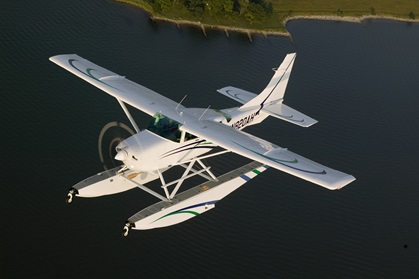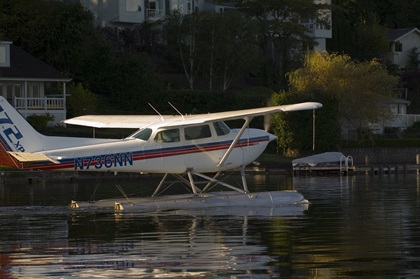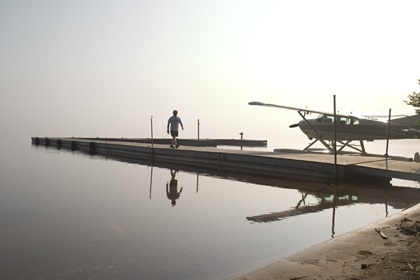Pat Brown is AOPA's Texas Ambassador. He is a Gold Seal Flight Instructor for gliders, single, and multi-engine aircraft, with over 5,500 hours of instruction given.
Earning your seaplane rating is arguably the most fun you’ll have in an airplane. It doesn’t take long, and the check ride is straightforward with no surprises.
You may be wondering how different flying a seaplane is. Well, you’ll be pleasantly surprised to find that flying a seaplane is pretty much the same as flying a land plane. Pull back, go up. Push forward, go down. Round out on short final, flare and touch down softly (hopefully!). Pretty much the same. The differences become apparent when you’re operating on the water. You see, seaplanes, for the most part, are lousy boats!

You’ll generally start out by learning seaplane terminology. If you have some previous boating experience, then terms like keel, step and chine will be familiar to you. No boating experience? No problem. These terms are easy to learn. In fact, the Seaplane Pilots Association is an excellent place to start. Their web site is: https://www.seaplanepilotsassociation.org/
There are two basic types of seaplanes. One type has a boat-style hull and may have “sponsons” that extend from the underside of each wing to keep the wings from touching the water. These seaplanes have retractable landing gear that remain retracted for water operations.
The other is a ‘normal’ airplane that has been retrofitted with floats. Amphibious floats have retractable wheels which allow the seaplane to operate off both runways and water. The benefit of amphibious floats is obvious: maximum flexibility! Straight floats, on the other hand, limit the seaplane’s operation to water only, but the benefit of straight floats is a weight savings of around 300 pounds!
While virtually any ‘normal’ airplane can be fitted with floats, high wing airplanes are the most common due to dock clearance and other issues.
During your training, you’ll learn how to idle taxi, plow taxi, and step taxi. Wind and water conditions dictate which is appropriate but idle taxi is the most common if you’re not in a hurry and if the wind isn’t too strong.
 You’ll also learn how to ‘sail.’ Yes, you can use the wind, along with placement of flight controls, to actually ‘sail’ the seaplane. This is typically done when the engine is shut down. And, since the seaplane will naturally weathervane into the wind, you’re going to be sailing backwards! Sailing can be used if you want to reposition the airplane downwind so as to maximize your take-off distance.
You’ll also learn how to ‘sail.’ Yes, you can use the wind, along with placement of flight controls, to actually ‘sail’ the seaplane. This is typically done when the engine is shut down. And, since the seaplane will naturally weathervane into the wind, you’re going to be sailing backwards! Sailing can be used if you want to reposition the airplane downwind so as to maximize your take-off distance.There are several take off and landing techniques you’ll learn, too. Of course, there’s the ‘normal’ take off and landing but there are also special techniques for rough water, confined areas, crosswinds, and glassy water.
Do you know how to ‘read’ the water? Waves generally line up perpendicular to the wind. Look at the shoreline. If the surface is smooth and glassy, then the wind is blowing from that direction. If conditions are right, you may see ‘streaking’ on the surface. Streaking will be perpendicular to the waves and will line up with the wind. You may also notice circular or ‘odd’ shapes on the surface of the water. These are commonly called “paw prints’ and can signal the presence of gusty winds. At around 10 mph, small whitecaps can begin to form. That may mean using your rough water takeoff or landing technique. Remember, there are no shock absorbers built into your seaplane so you’ll feel ALL the bumps. It may be best not to operate in conditions like that.
Finally, you’ll learn how to properly beach, dock, and ramp the seaplane. Beaching is pretty simple. Just approach the shoreline slowly and wait until the floats (or the hull if you’re in a boat hull style seaplane) contact the bottom. Docking requires a little more skill and judgement. Approach too fast, or shut down the engine too late, and you’ll hit the dock with a jolt. If you approach too slow and shut the engine down too soon, you won’t make it! If you are in an amphibious seaplane, you may wish to land in the water and taxi up onto the land. For that, you’ll need to find a boat ramp. Approach the ramp slowly and, just before contact, add some power and ‘drive’ up the ramp!

As with all other aspects of seaplane flying, there are some “tricks of the trade” to learn. If idle taxi is too fast, pull the carb heat. Still too fast, turn off one mag. If you need to slow down even more, and depending on where the wind is coming from, lower the flaps if you have them! Your instructor will have plenty of helpful suggestions.
As mentioned above, this is a ‘rating,’ not an endorsement. It requires a check ride. Of course, check rides should never be taken for granted but this is one that should actually be fun. You’ll simply demonstrate to the examiner that you can perform all of the maneuvers described above in a safe manner. You’re not expected to fly with the prowess of an Alaskan bush pilot!
There are a number of flight schools around the country that offer seaplane training. The Seaplane Pilots Association is an excellent resource for this, too. Here’s a link to a list of seaplane flight schools in the US: https://www.seaplanepilotsassociation.org/resources/seaplane-schools/Prices vary with location and equipment but you can expect to pay somewhere in the neighborhood of $2,300-$2,500. Shop around to find the best fit for you and your budget.
If earning your seaplane rating is a bucket list item then, by all means, do it. Now!